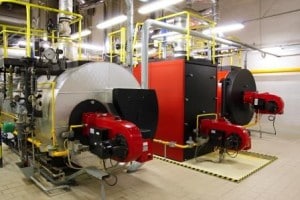Facilities emitting 25,000 metric tons of CO2e annually are required by the EPA to report annual greenhouse gas emissions per EPA mandate 40 CFR Part 98. Subpart C covers reporting for stationary sources of combustion.
General Stationary Fuel Combustion

Subpart C of 40 CFR 98 covers all aspects of general stationary fuel sources, which combust fuel, usually to produce electricity, generate steam, or provide energy for industrial, commercial, or institutional use. Alternatively, they can decrease waste by removing combustible matter.
These combustion sources include boilers, furnaces, engines, combined-cycle and straightforward combustion turbines, process heaters, and incinerators. They are found in commercial buildings and various industries, including refineries, chemical plants, paper mills, natural gas production fields, and pipelines.
Subpart C requires GHG reporting for CO2, CH4, and N2O, which are waste products in fossil fuel combustion. One method facilities can use to report emissions from combustion sources is continuous emission monitoring (CEM). Here, the facility measures the total flow rate of exhaust gas and the individual concentrations of CO2, CH4, and N2O in a total gas flow. This method is costly and requires ongoing maintenance.
To simplify reporting, the EPA permits the facility to measure fuel consumption throughout a year and then apply EPA formulas that calculate the emissions of various GHGs. The formulas are in 40 CFR 98 Subpart C. A facility fueled by natural gas or biogas can easily measure (totalize) the fuel used with a flow meter and apply the EPA formulas. Since the EPA has different factors for each type of energy, a facility using other fuels will need to totalize each fuel type’s consumption.
Measuring Emissions
Earlier in this series, I established that thermal flow meters excel in greenhouse gas monitoring. I even submitted that the Sage Meter is the best choice for measuring GHG in many environmental applications for many reasons, one of which is that it meets the EPA calibration requirements.
When measuring gas mass flow with thermal flow meters, temperature or pressure compensation is not required like in many other flow measurement technologies. With no moving parts, thermal flow meters have fewer maintenance and repair issues than other technologies.
The SAGE meter is easy to install and provides a direct mass flow. A built-in totalizer also offers the total flow in SCF (or NCM) over the measured time. The SAGE meter has an extremely low-end sensitivity, which is needed in this application. It can be calibrated onsite through the easy in-situ calibration check without removing the meter from the pipe, fully complying with the EPA flow measurement standards.
To read the Sage Metering white paper “Greenhouse Gas Emissions Monitoring Using Thermal Mass Flow Meters,” visit Sage GHG Emissions White Paper.

